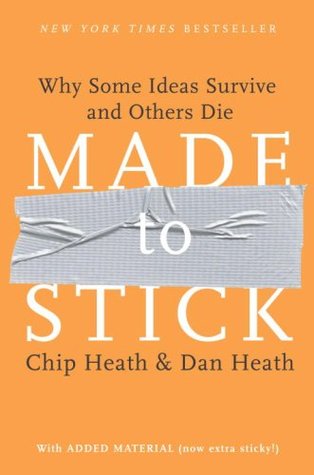This is Part 1 of a seven-part series on making speeches and presentations memorable. It is based on the book Made to Stick by Chip and Dan Heath.
Good speakers are memorable. Come to think of it, bad speakers are also memorable, albeit for different reasons.
Being memorable, making our message resonate with our audiences and stay with them – that is the Holy Grail of public speaking. Whether we are trying to inspire nations or a high school basketball team; whether we are trying to raise millions in venture capital or sell a few products at a local trade show; whether we are trying to persuade management to increase our department’s funding or trying to persuade our teenagers to clean their rooms (if you have figured this last one out, please contact me!) – the one common objective is that we want our messages to be remembered.
Easy to say, not so easy to do. Every day, our attention is pulled in thousands (yes, thousands) of directions by TV, radio, email, phone calls, meetings, advertisements, families, friends, colleagues, etc., etc., etc.
A German psychologist named Hermann Ebbinghaus studied memory and developed, among other things, what is known as the Forgetting Curve. Essentially, the Forgetting Curve shows the declining rate at which we retain information after hearing it. Ebbinghaus found that after only 20 minutes, we have forgotten almost 42% of what we have heard! After one hour, we have forgotten almost 56%. After one day we have forgotten 66% and after one week almost 75%.
Pretty grim statistics. And keep in mind that Ebbinghaus passed away in 1909, long before the advent of personal computers, the Internet, the Blackberry and Reality TV. How do we compete when it is our turn to speak? We are like salmon swimming upstream, fighting against rapids, rocks and predators.
Fortunately, there are ways to make our messages memorable, and that is what this seven-part series is all about. The basis of this series is a terrific book that I highly recommend: Made to Stick by Chip and Dan Heath.
The Heaths begin by asking two questions: Why do some ideas thrive while others die? And how do we improve the chances of worthy ideas? They then proceed to answer them.
Drawing on research and examples from all walks of life, the Heaths have found that “sticky” messages possess six qualities. They are Simple, Unexpected, Concrete, Credible, Emotional and come with Stories: “SUCCESs”.
“Made to Stick” is interesting, entertaining and full of ideas on how we can make our messages memorable. A comprehensive analysis of everything in the book is beyond the scope of this blog. However, over the next six posts, I will examine each of the Heaths’ indicia of “stickiness”. My hope is that this series will stimulate your thinking about ways in which to make your next speech or presentation compelling, memorable and, well, stickier.
For the next post in the series, please click here.

















10 Replies to “Making it stick: Introduction”
Do you know if people remember better/longer if it’s something they’ve read versus something they’ve heard? In other words, how effective are visual aids in making a talk memorable?
Thanks for the question Olive.
Different people have different learning preferences. However, on the whole, I think that well chosen visuals will greatly improve the chances that your audience will remember the message. In his book, “Presentation Zen”, Garr Reynolds talks about the “picture superiority effect” which states that pictures are remembered better than words, especially when people are exposed to the information for a limited time. And using pictures and words together will reinforce your message. Think back to the last PowerPoint you saw that was just slide after slide of bullet points and then compare it with a PowerPoint that had pictures (if you were ever fortunate enough to come across such a rare beast!). Which do you remember best?
If you are interested in pursuing this issue, I would also suggest that you have a look at Ned Herrmann’s “Whole Brain Model”. There are lots of sites on the Web that discuss it in detail. Herrmann found that there are four quadrants in the brain: logical, sequential, interpersonal and intuitive. Everyone has a preference for the way in which they think and learn. Thus, for example, some people will like lots of data and statistics while others will prefer personal stories. It is a fascinating topic and one that provides great insights into preparing a presentation that suits all learning preferences.
I hope that this helps. Thanks for following my blog.
John
Hurry up, John! I’m taking Communications 103 and I want to ace it. Looking forward to future instalments!
M
Thanks, Melissa! Mea culpa. I have had 5 speaking engagements this week and the blog has suffered accordingly. I will make up for it soon. Best of luck with the course. That you will ace it, I have no doubt. John